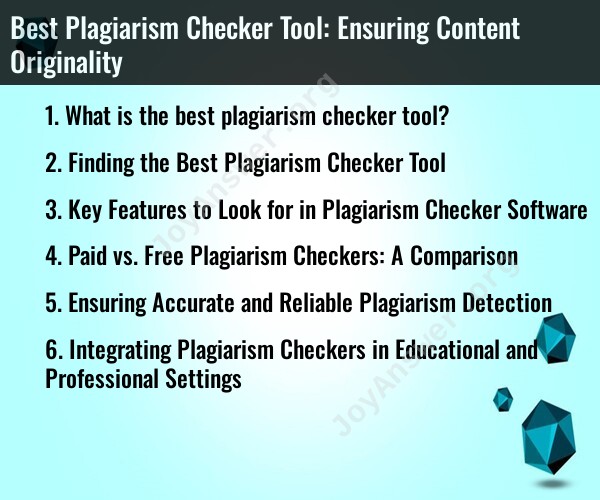What is the best plagiarism checker tool?
Determining the "best" plagiarism checker tool can be subjective, as it often depends on your specific needs, budget, and preferences. However, I can provide you with a list of popular and highly regarded plagiarism checker tools that you can consider. Each of these tools has its own unique features and pricing, so you can choose the one that best suits your requirements:
Turnitin: Often used by educational institutions, Turnitin is a well-known plagiarism checker that checks documents against a vast database of academic content. It's designed for teachers and students to ensure the originality of academic papers.
Grammarly Plagiarism Checker: Grammarly offers a plagiarism checker as part of its premium subscription. It's widely used for checking both academic and professional content for plagiarism.
Copyscape: Copyscape is a web-based plagiarism checker primarily used to find duplicate content on the internet. It's commonly used by website owners and content creators to protect their online content from plagiarism.
Plagscan: Plagscan is a comprehensive plagiarism detection tool that is popular in academic and publishing settings. It offers features like a detailed report and integration with learning management systems.
DupliChecker: DupliChecker is a free online plagiarism checker that can be used for basic plagiarism checks. It's a simple and user-friendly tool for quick scans.
Quetext: Quetext is a user-friendly online plagiarism checker that offers a free version with limited checks and a paid premium version with more features.
ProWritingAid: ProWritingAid is a writing and editing tool that includes a plagiarism checker. It's used by writers and content creators to improve writing quality and check for plagiarism.
**Copia: Copia is an AI-powered plagiarism checker tool designed for students, writers, and businesses. It provides real-time checking and in-depth reports.
PlagiarismCheck.org: PlagiarismCheck.org offers online plagiarism detection services, which can be used for academic, professional, and publishing purposes.
Scribbr: Scribbr's plagiarism checker is tailored for students and academics, with a focus on academic papers and theses.
Remember that the best plagiarism checker for you depends on your specific needs and preferences, and whether you require it for academic, professional, or online content purposes. Additionally, some tools offer free versions with limited features, while others require a subscription or one-time payment for more comprehensive checks and features. Always ensure that you use such tools responsibly and adhere to copyright and intellectual property guidelines.
Finding the Best Plagiarism Checker Tool
There are many plagiarism checker tools available, both free and paid. When choosing a plagiarism checker tool, it is important to consider the following factors:
- Accuracy: The plagiarism checker should be able to accurately detect plagiarism, even in heavily edited or paraphrased text.
- Features: The plagiarism checker should have the features that you need, such as the ability to check multiple sources, generate reports, and exclude quotes and references.
- Ease of use: The plagiarism checker should be easy to use and navigate.
- Price: Plagiarism checker tools can range in price from free to hundreds of dollars per year. Choose a tool that fits your budget and needs.
Key Features to Look for in Plagiarism Checker Software
Here are some key features to look for in plagiarism checker software:
- Comprehensive database: The plagiarism checker should have a comprehensive database of sources to compare your text against.
- Advanced matching algorithms: The plagiarism checker should use advanced matching algorithms to detect plagiarism, even in heavily edited or paraphrased text.
- Detailed reports: The plagiarism checker should generate detailed reports that show you where any instances of plagiarism were found.
- Support for multiple file formats: The plagiarism checker should be able to check files in multiple formats, such as Word, PDF, and Google Docs.
- Integration with other software: The plagiarism checker should integrate with other software, such as learning management systems (LMSs) and word processors.
Paid vs. Free Plagiarism Checkers: A Comparison
Paid plagiarism checker tools typically offer more features and more accurate plagiarism detection than free plagiarism checker tools. However, free plagiarism checker tools can be a good option for students and occasional users.
Here is a comparison of paid and free plagiarism checker tools:
| Feature | Paid | Free |
|---|---|---|
| Accuracy | Higher | Lower |
| Features | More | Fewer |
| Ease of use | Easier to use | More difficult to use |
| Price | Paid | Free |
Ensuring Accurate and Reliable Plagiarism Detection
To ensure accurate and reliable plagiarism detection, it is important to choose a plagiarism checker tool that uses a variety of methods to detect plagiarism. These methods may include:
- Text matching: This method compares your text against a database of sources to see if there are any exact matches.
- Paraphrase detection: This method uses advanced algorithms to detect plagiarism, even if the text has been heavily edited or paraphrased.
- Citation detection: This method detects plagiarism by identifying citations that are missing or incorrect.
Integrating Plagiarism Checkers in Educational and Professional Settings
Plagiarism checkers can be integrated into educational and professional settings in a variety of ways. For example, plagiarism checkers can be integrated with LMSs to allow students to check their work for plagiarism before submitting it. Plagiarism checkers can also be integrated with word processors to allow professionals to check their work for plagiarism before submitting it to clients or colleagues.
Here are some examples of how plagiarism checkers can be integrated into educational and professional settings:
- Schools: Schools can use plagiarism checkers to help students learn about plagiarism and to prevent students from submitting plagiarized work.
- Businesses: Businesses can use plagiarism checkers to ensure that their employees are producing original work.
- Publishers: Publishers can use plagiarism checkers to ensure that the content they publish is original.
- Journal editors: Journal editors can use plagiarism checkers to ensure that the articles they publish are original and have not been plagiarized from other sources.
Conclusion
Plagiarism checkers can be a valuable tool for students, professionals, and publishers. By choosing the right plagiarism checker tool and using it correctly, you can help to ensure that your work is original and plagiarism-free.












